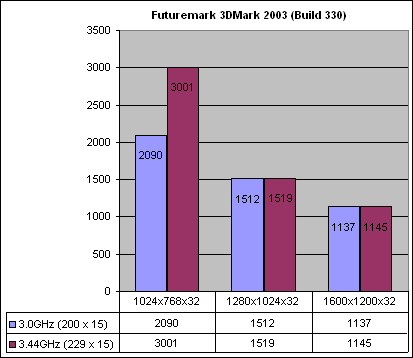Inno3D GeForce FX 5600
Review by Michael Tran on 07.01.2003
Video Card Provided by InnoVISION
Suggested Retail Price: $249.00
Street Price: $167.00
Performance:
Setup:
Hardware:
AOpen AX4SG Max Motherboard (Provided by AOpen)
Intel 3.0 GHz 800 MHz FSB Hyperthread CPU (Provided by Intel)
Inno3D Tornado GeForce FX 5600 (Provided by InnoVISION) (Inno3D Tornado Universal Drivers Version 43.51 (WHQL))
2 x 256 MB Corsair XMS PC3200 CAS2 DDR RAM
Western Digital Special Edition 120GB Hard Drive
Lite-On 52x24x52 CD-RW
Windows XP Professional Service Pack 1
Programs Used:
Futuremark 3DMark 2001 SE (Build 330)
Futuremark 3DMark 2003 (Build 330)
Comanche 4
Jedi Knight 2
Unreal Tournament 2003
Benchmark Results:
The benchmarks were run with the CPU clocked at its stock speed (3.0 GHz) and then with the CPU overclocked to 3.44 GHz. This shows how at lower resolutions, the 3d engines aren't being pushed to their limits, so much of the performance is still determined by the CPU. At higher resolutions, the number of visible verticies, models, and texture sizes is markedly increased, and thus the demands on the GPU and graphics data bus maximize the graphics card's capabilities. This explains why the difference between the benchmarks with the CPU at 3.0 GHz and 3.44 GHz diminish, or even disappear, at higher resolutions.
Futuremark 3DMark 2001 SE (Build 330)

The Inno3D GeForce FX 5600 scores decently with 11061 at 1024x768x32; overclocking at this resolution gives it an extra 236 point boost at 3.44GHz. As the resolutions get higher, the improvements of overclocking decrease, showing the limits of the video card. The overclocked score increase at 1280x1024x32 is only 131 at 3.44GHz and the score improvement at 1600x1200x32 is a mere 65 points.
Futuremark 3DMark 2003 (Build 330)

As tests get more intensive and constantly reach the limits of the video card, the improvements continue to decrease as the processor speed is increased. This comes to show that the processor is only one factor in performance; the video card has to perform just as well. Futuremark 3DMark 2003, based on DirectX 9, is definitely the program to test the limits of a video card. As shown through the tests, overclocking did not improve the scores by much. The video card could not outperform the test.
Comanche 4

Similarly, in Comanche 4, frame rates barely improved when the system was overclocked. Notice that the frame rates only increased by only 0.50 at 1024x768x32 and only 0.02 at 1600x1200x32.
Unreal Tournament 2003 Flyby

In Unreal Tournament 2003 (Flyby), there was zero improvement past 1024x768x32 when overclocked. The scores were identical or marginally increased.
Unreal Tournament 2003 Botmatch

In the botmatch, improvements increased more than the flyby. At 1024x768x32, the frame rates increased by about 3.2 while at 1600x1200x32, the frame rates increased by only 0.03.
Jedi Knight II

Lastly, in Jedi Knight II, the improvements from the overclock were not dramatic, but notice how high the scores were. This shows how easily the FX 5600 can handle this game, which runs off the four-year-old Quake 3 engine.
| « Previous Page | Next Page » |


